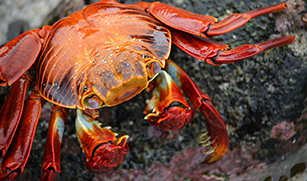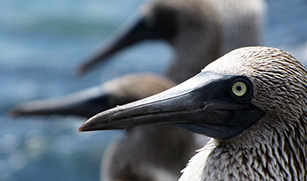Area: 986 km2 or 381 mi2
Maximum Altitude: 864 m or 2835 ft
Human Population: Approximately 12,000 residents
HISTORY
The Galapagos Islands are part of Ecuador and are located on the Equator. Volcanic activity has long since ceased on Santa Cruz, the second largest of the Galapagos Islands and located in the center of the archipelago. The name Santa Cruz is Spanish for “Holy Cross”, but its English name "Indefatigable" is after the British vessel HMS Indefatigable. Santa Cruz has a long history of human settlement and agriculture, which has left the landscape permanently altered by invasive species. Human development began in the 20th century on Santa Cruz when settlers from the United States and Europe moved to the area between WWI and WWII. The variety of geology, wildlife, and vegetation attracted settlers. The small towns of Bellavista and Santa Rosa were established in the humid highlands, where farmers raised cattle and planted crops such as avocados, coffee, sugarcane, bananas, oranges, and lemons.

TODAY
Santa Cruz is the main tourism hub for all of Galapagos, due to its proximity to the airport which is located in Baltra to the north. It is the only island in Galapagos where tourists can readily experience the interior and higher elevations of a Galapagos island. Santa Cruz has the longest paved road in Galapagos, which runs north-south across the island, taking people from the ferry at Itabaca Canal on the north coast into the highlands and through a few smaller towns on its way down to Puerto Ayora, the island’s largest city located on the southern coast of the island in Academy Bay.

CONSERVATION CHALLENGES
The Galapagos Islands have experienced accelerated development due to recent rapid growth in both tourism and population. Santa Cruz Island, and more specifically the town of Puerto Ayora, have withstood the brunt of this growth. In addition to the problem of introduced species and the ever-greater probability of introductions, this growth has put increasing pressures on local resources and municipalities – in terms of health, education, waste management, and many other aspects of daily life. For example, until recently, the waste produced by the community was taken to a dump where it was left untreated. In 2006, through the joint efforts of the community and the Galapagos National Park, the “Fabricio Valverde Environmental Center” was established outside of Puerto Ayora to provide recycling of 40% of the waste materials generated in Santa Cruz.
Conservation of nature can only be achieved when the local population can live sustainably,both economically and in terms of resources.
Puerto Ayora
Situated in Academy Bay on the southern coast of Santa Cruz, Puerto Ayora is a port town where sailboats fill the bay, sea birds fill the air, and marine iguanas dot the shore. Puerto Ayora is the heart and soul of the Galapagos Islands’ human population and is the main tourism hub in the archipelago.
Known for its quaint hotels with creative architecture and small restaurants with delicious seafood, Puerto Ayora is the base point for most tours and offers the most services in Galapagos, including a hospital, banks, post office, radio station and a TAME airline office. Most travelers to the Galapagos will make a stop in Puerto Ayora during their trip.

.png)
